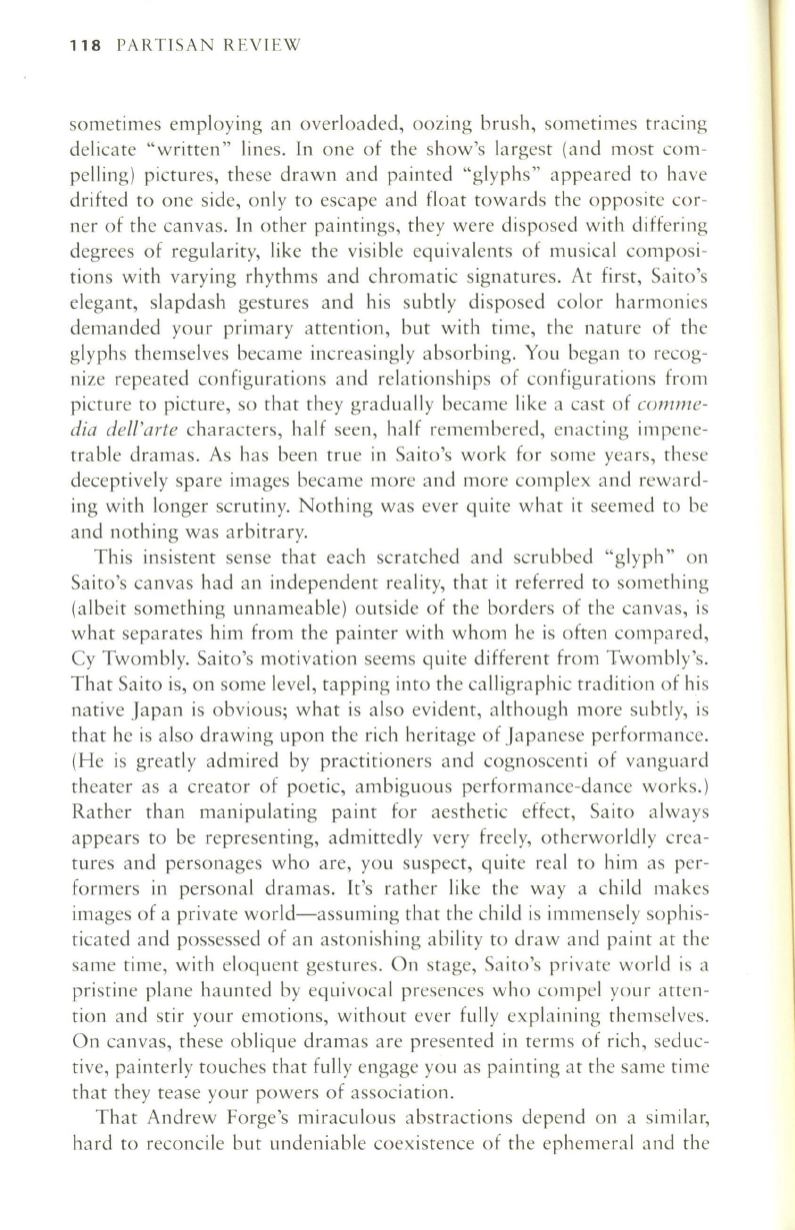
118
PARTISAN REVIEW
sometimes employing an overloaded, oozing brush, sometimes tracing
delicate "written" lines.
Tn
one of the show's largest (and most com–
pelling) pictures, these drawn and painted "glyphs" appeared to have
drifted to one side, only to escape and float towards the opposite cor–
ner of the canvas.
In
other paintings, they were disposed with differing
degrees of regularity, like the visible equivalents of musical composi–
tions with varying rhythms and chromatic signatures. At first, Saito's
elegant, slapdash gestures and his subtly disposed color harmonies
demanded your primary attention, but with time, the nature of the
glyphs themselves became increasingly absorbing. You began to recog–
nize repeated configurations and relationships of configurations from
picture to picture, so that they gradually became like a cast of
comme–
dia dell'arte
characters, half seen, half remembered, enacting impene–
trable dramas. As has been true in Saito's work for some years, these
deceptively spare images became more and more complex and reward–
ing with longer scrutiny. Nothing was ever quite what it seemed to be
and nothing was arbitrary.
This insistent sense that each scratched and scrubbed "glyph" on
Saito's canvas had an independent reality, that it referred to something
(albeit something unnameable) outside of the borders of the canvas, is
what separates him from the painter with whom he is often compared,
Cy Twombly. Saito's motivation seems quite different from Twombly's.
That Saito is, on some level, tapping into the calligraphic tradition of his
native Japan is obvious; what is also evident, although more subtly, is
that he is also drawing upon the rich heritage of Japanese performance.
(He is greatly admired by practitioners and cognoscenti of vanguard
theater as a creator of poetic, ambiguous performance-dance works.)
Rather than manipulating paint for aesthetic effect, Saito always
appears to be representing, admittedly very freely, otherworldly crea–
tures and personages who are, you suspect, quite real to him as per–
formers in personal dramas. It's rather like the way a child makes
images of a private world-assuming that the child is immensely sophis–
ticated and possessed of an astonishing ability to draw and paint at the
same time, with eloquent gestures. On stage, Saito's private world is a
pristine plane haunted by equivocal presences who compel your atten–
tion and stir your emotions, without ever fully explaining themselves.
On canvas, these oblique dramas are presented in terms of rich, seduc–
tive, painterly touches that fully engage you as painting at the same time
that they tease your powers of association.
That Andrew Forge's miraculous abstractions depend on a similar,
hard to reconcile but undeniable coexistence of the ephemeral and the


